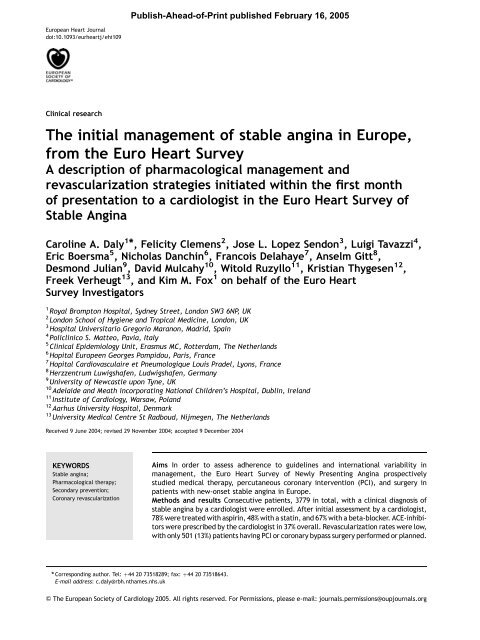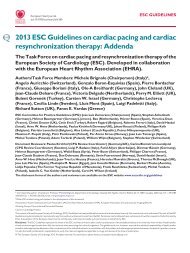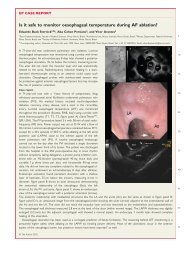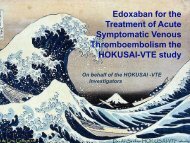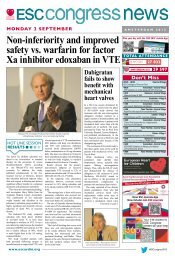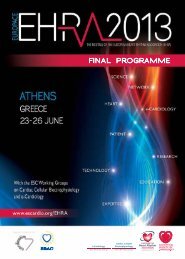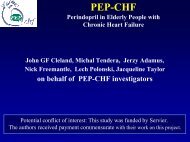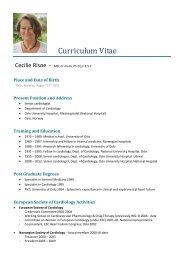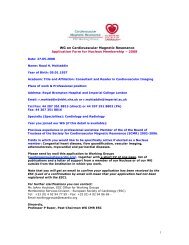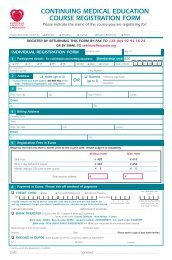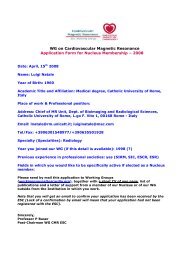EHS on Stable angina - Main publication - European Society of ...
EHS on Stable angina - Main publication - European Society of ...
EHS on Stable angina - Main publication - European Society of ...
Create successful ePaper yourself
Turn your PDF publications into a flip-book with our unique Google optimized e-Paper software.
<strong>European</strong> Heart Journal<br />
doi:10.1093/eurheartj/ehi109<br />
Clinical research<br />
The initial management <strong>of</strong> stable <strong>angina</strong> in Europe,<br />
from the Euro Heart Survey<br />
A descripti<strong>on</strong> <strong>of</strong> pharmacological management and<br />
revascularizati<strong>on</strong> strategies initiated within the first m<strong>on</strong>th<br />
<strong>of</strong> presentati<strong>on</strong> to a cardiologist in the Euro Heart Survey <strong>of</strong><br />
<strong>Stable</strong> Angina<br />
Caroline A. Daly 1 *, Felicity Clemens 2 , Jose L. Lopez Send<strong>on</strong> 3 , Luigi Tavazzi 4 ,<br />
Eric Boersma 5 , Nicholas Danchin 6 , Francois Delahaye 7 , Anselm Gitt 8 ,<br />
Desm<strong>on</strong>d Julian 9 , David Mulcahy 10 , Witold Ruzyllo 11 , Kristian Thygesen 12 ,<br />
Freek Verheugt 13 , and Kim M. Fox 1 <strong>on</strong> behalf <strong>of</strong> the Euro Heart<br />
Survey Investigators<br />
1<br />
Royal Brompt<strong>on</strong> Hospital, Sydney Street, L<strong>on</strong>d<strong>on</strong> SW3 6NP, UK<br />
2<br />
L<strong>on</strong>d<strong>on</strong> School <strong>of</strong> Hygiene and Tropical Medicine, L<strong>on</strong>d<strong>on</strong>, UK<br />
3<br />
Hospital Universitario Gregorio Maran<strong>on</strong>, Madrid, Spain<br />
4<br />
Policlinico S. Matteo, Pavia, Italy<br />
5<br />
Clinical Epidemiology Unit, Erasmus MC, Rotterdam, The Netherlands<br />
6<br />
Hopital Europeen Georges Pompidou, Paris, France<br />
7<br />
Hopital Cardiovasculaire et Pneumologique Louis Pradel, Ly<strong>on</strong>s, France<br />
8<br />
Herzzentrum Luwigshafen, Ludwigshafen, Germany<br />
9<br />
University <strong>of</strong> Newcastle up<strong>on</strong> Tyne, UK<br />
10<br />
Adelaide and Meath incorporating Nati<strong>on</strong>al Children’s Hospital, Dublin, Ireland<br />
11<br />
Institute <strong>of</strong> Cardiology, Warsaw, Poland<br />
12<br />
Aarhus University Hospital, Denmark<br />
13<br />
University Medical Centre St Radboud, Nijmegen, The Netherlands<br />
Received 9 June 2004; revised 29 November 2004; accepted 9 December 2004<br />
KEYWORDS<br />
<strong>Stable</strong> <strong>angina</strong>;<br />
Pharmacological therapy;<br />
Sec<strong>on</strong>dary preventi<strong>on</strong>;<br />
Cor<strong>on</strong>ary revascularizati<strong>on</strong><br />
Publish-Ahead-<strong>of</strong>-Print published February 16, 2005<br />
* Corresp<strong>on</strong>ding author. Tel: þ44 20 73518289; fax: þ44 20 73518643.<br />
E-mail address: c.daly@rbh.nthames.nhs.uk<br />
Aims In order to assess adherence to guidelines and internati<strong>on</strong>al variability in<br />
management, the Euro Heart Survey <strong>of</strong> Newly Presenting Angina prospectively<br />
studied medical therapy, percutaneous cor<strong>on</strong>ary interventi<strong>on</strong> (PCI), and surgery in<br />
patients with new-<strong>on</strong>set stable <strong>angina</strong> in Europe.<br />
Methods and results C<strong>on</strong>secutive patients, 3779 in total, with a clinical diagnosis <strong>of</strong><br />
stable <strong>angina</strong> by a cardiologist were enrolled. After initial assessment by a cardiologist,<br />
78% were treated with aspirin, 48% with a statin, and 67% with a beta-blocker. ACE-inhibitors<br />
were prescribed by the cardiologist in 37% overall. Revascularizati<strong>on</strong> rates were low,<br />
with <strong>on</strong>ly 501 (13%) patients having PCI or cor<strong>on</strong>ary bypass surgery performed or planned.<br />
& The <strong>European</strong> <strong>Society</strong> <strong>of</strong> Cardiology 2005. All rights reserved. For Permissi<strong>on</strong>s, please e-mail: journals.permissi<strong>on</strong>s@oupjournals.org
Page 2 <strong>of</strong> 12 C.A. Daly et al.<br />
Introducti<strong>on</strong><br />
The management <strong>of</strong> stable <strong>angina</strong> has two major objectives:<br />
to reduce or abolish the symptoms, and to<br />
improve prognosis. Some treatment opti<strong>on</strong>s have a well<br />
proven track record in achieving both aims; for example,<br />
revascularizati<strong>on</strong> in anatomically defined subgroups 1–4 or<br />
beta-blockade in the post-myocardial infarcti<strong>on</strong> (MI) populati<strong>on</strong>,<br />
5 but many sec<strong>on</strong>dary preventi<strong>on</strong> measures do not<br />
reduce symptoms. This absence <strong>of</strong> a direct effect <strong>on</strong> symptoms<br />
does not, however, diminish the importance <strong>of</strong> antiplatelet<br />
therapy and lipid-lowering therapy, particularly<br />
statin therapy, which should be universally prescribed<br />
in patients with clinically suspected cor<strong>on</strong>ary disease<br />
provided there are no c<strong>on</strong>traindicati<strong>on</strong>s, 6–8 and possibly<br />
also angiotensin c<strong>on</strong>verting enzyme (ACE) inhibitor<br />
therapy. 9,10 After such blanket sec<strong>on</strong>dary preventi<strong>on</strong><br />
therapy, treatment opti<strong>on</strong>s diversify rapidly and should<br />
be guided by clinical characteristics <strong>of</strong> the patient, including<br />
cardiovascular and n<strong>on</strong>-cardiovascular co-morbidity,<br />
patient tolerance, and patient preference.<br />
With regard to pharmacological treatment <strong>of</strong> <strong>angina</strong>,<br />
there are innumerable studies <strong>of</strong> the effect <strong>of</strong> comm<strong>on</strong><br />
anti-<strong>angina</strong>l drug classes (beta-blockers, calcium antag<strong>on</strong>ists,<br />
and nitrates), or combinati<strong>on</strong>s there<strong>of</strong>, <strong>on</strong> either<br />
symptoms or markers <strong>of</strong> ischaemia, silent or symptomatic,<br />
ambulatory or provoked. 7,11–13 Yet despite the<br />
high prevalence <strong>of</strong> <strong>angina</strong> and frequent need for anti<strong>angina</strong>l<br />
drug therapy, there are relatively few studies <strong>of</strong><br />
the prognostic effect <strong>of</strong> anti-<strong>angina</strong>l drug therapy, and<br />
even fewer with l<strong>on</strong>g-term follow-up. Beta-blockers are<br />
recommended as first line maintenance 6–8<br />
However, when restricted to patients with cor<strong>on</strong>ary disease documented within 4 weeks<br />
<strong>of</strong> assessment, over 50% had revascularizati<strong>on</strong> performed or planned. Am<strong>on</strong>g other<br />
factors, the nati<strong>on</strong>al rate <strong>of</strong> angiography and availability <strong>of</strong> invasive facilities significantly<br />
predicted the likelihood <strong>of</strong> revascularizati<strong>on</strong>, OR 2.4 and 2.0, respectively.<br />
C<strong>on</strong>clusi<strong>on</strong> This survey shows a shortfall between guidelines and practice with regard to<br />
the use <strong>of</strong> evidence-based drug therapy and evidence that revascularizati<strong>on</strong> rates are<br />
str<strong>on</strong>gly influenced by n<strong>on</strong>-clinical, in additi<strong>on</strong> to clinical, factors.<br />
therapy<br />
(after pro re nata nitrate) for patients with stable<br />
<strong>angina</strong> <strong>on</strong> the basis <strong>of</strong> results from post-MI studies<br />
extrapolated to the stable <strong>angina</strong> populati<strong>on</strong>.<br />
The 1997 <strong>European</strong> guidelines <strong>on</strong> the management <strong>of</strong><br />
<strong>angina</strong> suggest that revascularizati<strong>on</strong> should be c<strong>on</strong>sidered<br />
in patients who will benefit prognostically, 1–4 or in whom<br />
symptoms are not c<strong>on</strong>trolled by medical therapy.<br />
The purpose <strong>of</strong> this survey was to examine the initial<br />
management <strong>of</strong> newly presenting stable <strong>angina</strong> in its<br />
totality, including the adherence to guidelines and<br />
evidence-based practice in the pharmacological treatment<br />
<strong>of</strong> <strong>angina</strong>, and to attempt to examine some <strong>of</strong> the<br />
factors predictive <strong>of</strong> the decisi<strong>on</strong> to revascularize.<br />
Methods<br />
The methodology <strong>of</strong> the Euro Heart Survey (<str<strong>on</strong>g>EHS</str<strong>on</strong>g>) <strong>of</strong> <strong>Stable</strong> Angina<br />
is described in the compani<strong>on</strong> paper. 14 Briefly, to ensure that the<br />
populati<strong>on</strong> studied was representative <strong>of</strong> the stable <strong>angina</strong> populati<strong>on</strong>,<br />
and not a pre-selected group <strong>of</strong> stable patients admitted<br />
to hospital for catheterizati<strong>on</strong> or revascularizati<strong>on</strong>, the survey<br />
was performed <strong>on</strong> community-based patients presenting to a<br />
cardiologist as an outpatient. Participating centres (197) were<br />
a mix <strong>of</strong> academic and n<strong>on</strong>-academic instituti<strong>on</strong>s, and hospitals<br />
with and without interventi<strong>on</strong>al and cardiac surgical facilities.<br />
The patient populati<strong>on</strong> was composed <strong>of</strong> patients at a new<br />
presentati<strong>on</strong> to a cardiologist in whom a diagnosis was made <strong>of</strong><br />
stable <strong>angina</strong>, caused by myocardial ischaemia due to cor<strong>on</strong>ary<br />
disease based <strong>on</strong> clinical assessment, and who did not have<br />
unstable <strong>angina</strong>. A new presentati<strong>on</strong> was defined as a first ever<br />
presentati<strong>on</strong> to a cardiologist, or new referral or re-referral<br />
after a period <strong>of</strong> at least 1 year <strong>of</strong> not attending (c<strong>on</strong>sulting) a<br />
cardiologist. Patients who required hospitalizati<strong>on</strong> within 24 h<br />
<strong>of</strong> the initial c<strong>on</strong>sultati<strong>on</strong>, and were therefore c<strong>on</strong>sidered<br />
likely to have unstable <strong>angina</strong> in a proporti<strong>on</strong> <strong>of</strong> cases, were<br />
excluded from the survey, as were patients who had a prior<br />
history <strong>of</strong> revascularizati<strong>on</strong>, either percutaneous or surgical, or<br />
aetiology other than cor<strong>on</strong>ary disease, for example significant<br />
aortic stenosis, or hypertrophic cardiomyopathy. For all patients,<br />
the immediate medical treatment recommended, and follow-up<br />
arrangements were recorded. Anti-<strong>angina</strong>l drugs were defined as<br />
drugs intended to alleviate symptoms or ischaemia, such as betablockers,<br />
calcium antag<strong>on</strong>ists, nitrates, nicorandil, or metabolic<br />
agents such as trimetazidine. In the case <strong>of</strong> guideline recommended<br />
treatments (anti-platelet therapy, statin therapy,<br />
and beta-blockade) not being prescribed, the investigator was<br />
asked to select a reas<strong>on</strong> why the drug was not prescribed. The<br />
results <strong>of</strong> investigati<strong>on</strong>s performed, and changes to the initial<br />
management plan, including revascularizati<strong>on</strong> procedures performed<br />
or planned, were also recorded 4 weeks after assessment.<br />
Data management<br />
The data were collected electr<strong>on</strong>ically by the investigators and<br />
stored centrally at the <strong>European</strong> <strong>Society</strong> <strong>of</strong> Cardiology based in<br />
Nice, France. The data collecti<strong>on</strong> s<strong>of</strong>tware ran initial c<strong>on</strong>sistency<br />
checks at data entry level, with further checking performed<br />
by submitting the database to c<strong>on</strong>sistency checks as<br />
per a pre-written validati<strong>on</strong> plan using SAS s<strong>of</strong>tware. Missing or<br />
inc<strong>on</strong>sistent values were thus highlighted automatically and<br />
queried by the data management team using ph<strong>on</strong>e or e-mail<br />
c<strong>on</strong>tact with the investigators.<br />
Statistical analysis<br />
Regi<strong>on</strong>al analyses <strong>of</strong> treatment initiated were performed according<br />
to the North, West, Central, and Mediterranean divisi<strong>on</strong>s as<br />
previously used in <str<strong>on</strong>g>EHS</str<strong>on</strong>g> methodology. Descriptive statistics were<br />
used to quantify the frequency <strong>of</strong> use <strong>of</strong> pharmacological and<br />
other treatments at presentati<strong>on</strong>. The Student’s t-test or<br />
ANOVA technique were used as appropriate to test differences<br />
in quantitative measures, and the x 2 test was used to test
The initial management <strong>of</strong> stable <strong>angina</strong> Page 3 <strong>of</strong> 12<br />
differences in proporti<strong>on</strong>s. Two-sided P values are reported with<br />
0.05 used as critical value to define statistical significance.<br />
Logistic regressi<strong>on</strong> was employed to define determinants influencing<br />
early (within 4 weeks) decisi<strong>on</strong> to pursue a revascularizati<strong>on</strong><br />
strategy. Forwards and backwards stepwise procedures were<br />
used to select the most significant predictors <strong>of</strong> early revascularizati<strong>on</strong>,<br />
using P ¼ 0.05 as the significance level to enter, and<br />
P ¼ 0.05 as the significance level to stay. Variables c<strong>on</strong>sidered<br />
included clinical details such as age and sex, type <strong>of</strong> centre, comorbidity,<br />
symptom severity and durati<strong>on</strong>, prior anti-<strong>angina</strong>l<br />
drug therapy, the result <strong>of</strong> exercise or other stress testing, and<br />
the rate <strong>of</strong> angiography stratified as high or low according to<br />
the median rate in the country. Separate multivariable analysis<br />
was carried out for the countries which had a high rate <strong>of</strong> referral<br />
for cor<strong>on</strong>ary angiography (.median) and those which had a low<br />
rate <strong>of</strong> referral (,median). This method avoids problems due to<br />
intra-regi<strong>on</strong>al heterogeneity in angiography rates, and reflects<br />
the general type practice within the nati<strong>on</strong>al health service,<br />
and whether invasive or c<strong>on</strong>servative practice is adopted (in<br />
terms <strong>of</strong> angiography at least). It is similar to methods used in previous<br />
analyses <strong>of</strong> treatment and outcome in acute cor<strong>on</strong>ary syndromes<br />
according to prevailing rates <strong>of</strong> PCI. 15 All analyses were<br />
undertaken using STATA TM statistical s<strong>of</strong>tware.<br />
Results<br />
Details <strong>of</strong> the patient populati<strong>on</strong> and the investigati<strong>on</strong>s<br />
which were performed or planned as a result <strong>of</strong> assessment<br />
by a cardiologist are briefly described. The majority<br />
<strong>of</strong> patients had been referred by a primary care physician<br />
(71%). The populati<strong>on</strong> was young, the mean age <strong>of</strong> the<br />
3779 patients included in the survey was 61 years, and<br />
58% were male. There was a high prevalence <strong>of</strong> modifiable<br />
cardiovascular risk. A large proporti<strong>on</strong>, 2879 (76%),<br />
<strong>of</strong> patients had had, or were scheduled to have, an<br />
exercise ECG, and 1564 (41%) a cor<strong>on</strong>ary angiogram,<br />
after the initial c<strong>on</strong>sultati<strong>on</strong>. Regarding enrolment<br />
from different types <strong>of</strong> centre, 28% <strong>of</strong> patients were<br />
from centres with n<strong>on</strong>-invasive facilities <strong>on</strong>ly, 26% from<br />
centres with invasive facilities <strong>on</strong> site but without<br />
cardiac surgery, and 45% from centres with full facilities<br />
including cardiac surgery <strong>on</strong> site. The remaining 1%<br />
were recruited from sites which were not categorized.<br />
Immediate medical therapy recommended<br />
Prior to cardiology assessment, 49% <strong>of</strong> patients were<br />
taking aspirin and 22% <strong>of</strong> patients were taking a statin.<br />
Table 1 shows the frequency <strong>of</strong> use <strong>of</strong> sec<strong>on</strong>dary preventi<strong>on</strong><br />
and anti-<strong>angina</strong>l drugs in individual participating<br />
countries, after initial assessment by a cardiologist. The<br />
frequency <strong>of</strong> use <strong>of</strong> other cardiovascular medicati<strong>on</strong> is<br />
described in Table 2. After assessment by a cardiologist,<br />
81% <strong>of</strong> patients were taking or were recommended an<br />
anti-platelet agent, 78% aspirin. A statin was prescribed<br />
in 48%, beta-blockers in 67%, and 61% were <strong>on</strong> a<br />
nitrate. Only 27% were taking a calcium channel<br />
blocker and, with few internati<strong>on</strong>al excepti<strong>on</strong>s, the use<br />
<strong>of</strong> nicorandil and metabolic agents such as trimetazidine<br />
or ranolazine was limited to a small percentage <strong>of</strong> cases.<br />
The majority <strong>of</strong> patients (59%) were <strong>on</strong> two or more anti<strong>angina</strong>l<br />
drugs after assessment by a cardiologist, and <strong>on</strong>ly<br />
13% were <strong>on</strong> no anti-<strong>angina</strong>l drug (Figure 1 ). The number<br />
<strong>of</strong> anti-<strong>angina</strong>l drugs per patient did not differ according<br />
to sex, but increased significantly with age up to 70 years<br />
(P 0.002 for each decade increase in age up to 70<br />
years). The intensity <strong>of</strong> anti-<strong>angina</strong>l drug therapy was<br />
also related to the severity <strong>of</strong> symptoms, with those<br />
with less severe symptoms [Canadian Cardiovascular<br />
<strong>Society</strong> (CCS) Class I] more likely to be <strong>on</strong> no anti<strong>angina</strong>l<br />
medicati<strong>on</strong>, and those with more severe <strong>angina</strong><br />
(CCS Class III) more likely to be <strong>on</strong> several drugs after<br />
assessment (P , 0.001 for trend). There were 307<br />
patients with unclassified symptoms, <strong>of</strong> whom half were<br />
not prescribed anti-<strong>angina</strong>l therapy. For the majority <strong>of</strong><br />
these patients (66%) the reas<strong>on</strong> for not initiating betablockade<br />
was recorded as ‘awaiting investigati<strong>on</strong>s’.<br />
The reas<strong>on</strong>s for not prescribing sec<strong>on</strong>dary preventi<strong>on</strong><br />
treatment and beta-blockade in the overall populati<strong>on</strong><br />
are presented in Table 3. In the 834 patients not<br />
recommended aspirin, specific patient c<strong>on</strong>traindicati<strong>on</strong>s<br />
accounted for <strong>on</strong>ly 22% <strong>of</strong> the reas<strong>on</strong>s given for not prescribing<br />
aspirin. Just over half (52%) <strong>of</strong> these patients<br />
were prescribed an alternative anti-platelet agent. Of<br />
the patients in whom aspirin was not c<strong>on</strong>sidered indicated,<br />
11% were taking an alternative anti-platelet agent.<br />
Just <strong>on</strong>e-third <strong>of</strong> the populati<strong>on</strong> not already taking a<br />
statin were prescribed lipid-lowering therapy. Specific<br />
patient c<strong>on</strong>traindicati<strong>on</strong>s accounted for <strong>on</strong>ly 19% <strong>of</strong><br />
reas<strong>on</strong>s given for not prescribing a statin. In patients<br />
with a history <strong>of</strong> hyperlipidaemia, the use <strong>of</strong> statin<br />
therapy was c<strong>on</strong>siderably higher (70–85%), across all<br />
regi<strong>on</strong>s.<br />
ACE-inhibitors were prescribed in 40% <strong>of</strong> patients<br />
overall. However, the rate <strong>of</strong> prescripti<strong>on</strong> was higher<br />
(73%) in patients with clinical signs <strong>of</strong> heart failure. In<br />
diabetic patients ACE-inhibitors were also prescribed<br />
more frequently, with 56% <strong>of</strong> patients with diabetes<br />
receiving a recommendati<strong>on</strong> for ACE-inhibitor therapy.<br />
Planned follow-up<br />
After initial assessment, a follow-up visit was scheduled<br />
with the cardiologist for the majority <strong>of</strong> patients, 2725<br />
(72%), with a median wait for this visit <strong>of</strong> 41 days. The<br />
median wait for this review appointment varied from 70<br />
days in Northern Europe to 35 days in Central Europe.<br />
In total, <strong>on</strong>ly a quarter <strong>of</strong> patients had a definitive management<br />
plan (either revascularizati<strong>on</strong> or c<strong>on</strong>servative<br />
management with all investigati<strong>on</strong>s completed) in place<br />
4 weeks after initial assessment. The remainder <strong>of</strong><br />
patients c<strong>on</strong>tinued to await <strong>on</strong>e or more investigati<strong>on</strong>s 4<br />
weeks after assessment, or were observed for clinical progress<br />
before further management was instituted (Table 4 ).<br />
C<strong>on</strong>servative management (medical therapy <strong>on</strong>ly) with<br />
all investigati<strong>on</strong>s completed was planned in 452 patients<br />
(12%). In all, 354 (78%) <strong>of</strong> these patients had an exercise<br />
test, 35 (8%) stress echo, and 571 (3%) perfusi<strong>on</strong> scan.<br />
An angiogram was performed in 281 (62%). The clinical<br />
details <strong>of</strong> patients in whom c<strong>on</strong>servative management<br />
was adopted are shown in Table 5. In terms <strong>of</strong> guideline<br />
adherence and evidence-based practice, 400 (88%) <strong>of</strong><br />
the c<strong>on</strong>servative management group were treated with<br />
aspirin or an alternative anti-platelet agent, and 215
Page 4 <strong>of</strong> 12 C.A. Daly et al.<br />
Table 1 Frequency <strong>of</strong> use <strong>of</strong> sec<strong>on</strong>dary preventi<strong>on</strong> and anti-<strong>angina</strong>l drugs in patients from the <str<strong>on</strong>g>EHS</str<strong>on</strong>g> <strong>of</strong> <strong>Stable</strong> Angina<br />
Country n Aspirin<br />
(%)<br />
(48%) were <strong>on</strong> any form <strong>of</strong> lipid-lowering therapy (predominantly<br />
statin). Although these proporti<strong>on</strong>s are similar<br />
to those for the populati<strong>on</strong> as a whole, they are significantly<br />
lower than the proporti<strong>on</strong>s taking anti-platelet<br />
and lipid-lowering drugs in the revascularizati<strong>on</strong> group<br />
(88 vs. 96%, P , 0.001 and 45 vs. 77%, P , 0.001). More<br />
than 80% <strong>of</strong> the c<strong>on</strong>servatively managed patients were<br />
<strong>on</strong> two or more anti-<strong>angina</strong>l drugs.<br />
Revascularizati<strong>on</strong><br />
Statin<br />
(%)<br />
Betablocker<br />
(%)<br />
Only 161 patients, 4% <strong>of</strong> the populati<strong>on</strong> overall, had PCI<br />
performed within 4 weeks <strong>of</strong> presentati<strong>on</strong>, and 68 (2%)<br />
Nitrate<br />
(%)<br />
Calcium<br />
antag<strong>on</strong>ist (%)<br />
ACEinhibitor<br />
(%)<br />
Nicorandil<br />
(%)<br />
Northern Europe 85 61 68 67 29 21 6 1<br />
Denmark 70 54 24 31 43 26 10 0 3<br />
Finland 76 82 59 83 71 24 26 0 1<br />
Sweden 56 79 50 71 54 20 20 0 0<br />
UK 319 94 72 72 73 33 23 10 1<br />
Central Europe 89 55 77 77 29 61 2 17<br />
Albania 23 96 39 96 83 52 35 0 0<br />
Belarus 26 74 44 76 50 41 65 0 15<br />
Bosnia and<br />
Herzegovina<br />
20 100 50 95 100 15 75 0 0<br />
Bulgaria 30 100 67 93 83 33 83 0 43<br />
Croatia 52 96 69 81 67 33 56 2 0<br />
Czech Republic 42 90 31 79 83 24 45 0 2<br />
Georgia 45 98 51 64 84 33 56 0 38<br />
Hungary 30 83 67 87 80 27 73 0 0<br />
Latvia 18 83 39 83 94 22 50 0 28<br />
Lithuania 77 97 38 88 88 30 81 3 8<br />
Maced<strong>on</strong>ia 8 100 38 75 63 63 50 0 0<br />
Moldova 27 96 4 81 52 19 48 0 0<br />
Poland 571 90 66 77 72 26 62 3 20<br />
Romania 145 77 50 70 79 32 48 1 17<br />
Russian Federati<strong>on</strong> 57 89 49 90 81 39 81 0 12<br />
Serbia and<br />
M<strong>on</strong>tenegro<br />
8 88 63 75 38 0 88 0 0<br />
Slovakia 108 86 38 80 84 31 53 0 18<br />
Slovenia 30 77 80 63 93 33 50 3 0<br />
Ukraine 14 71 14 43 100 14 71 0 100<br />
Western Europe 52 30 52 35 18 23 ,1 1<br />
Austria 22 68 36 36 59 32 32 14 0<br />
Belgium 3 67 0 67 33 33 0 0 0<br />
France 20 95 70 95 55 40 15 10 10<br />
Germany 144 83 62 74 39 19 58 0 6<br />
The Netherlands 762 44 23 46 33 17 16 0 ,1<br />
Mediterranean<br />
Europe<br />
85 51 66 61 33 40 1 2<br />
Cyprus 46 89 63 74 41 9 39 0 0<br />
Greece 165 87 68 67 66 45 42 0 2<br />
Israel 67 94 80 76 33 30 34 1 6<br />
Italy 256 78 63 68 63 41 40 1 1<br />
Leban<strong>on</strong> 4 100 50 75 50 25 25 0 0<br />
Portugal 77 86 47 64 64 36 52 8 6<br />
Spain 263 83 60 54 66 25 34 2 2<br />
Overall 78 48 67 61 27 40 2 7<br />
Metabolic<br />
agent (%)<br />
had cor<strong>on</strong>ary artery bypass grafting (CABG) surgery. PCI<br />
was planned for an additi<strong>on</strong>al 155 (4%) <strong>of</strong> the populati<strong>on</strong><br />
and CABG for a further 151 (4%). A small number <strong>of</strong><br />
patients, 34 in total, had both procedures performed<br />
or planned within 4 weeks. In all, 501 patients (13%)<br />
had a revascularizati<strong>on</strong> procedure either performed or<br />
planned within 4 weeks <strong>of</strong> initial presentati<strong>on</strong>. The<br />
proporti<strong>on</strong> <strong>of</strong> men (17%) in the survey who had revascularizati<strong>on</strong><br />
either performed within 4 weeks or planned<br />
was twice that <strong>of</strong> women (8%). Initially these rates <strong>of</strong><br />
revascularizati<strong>on</strong> may appear low, but they refer to<br />
rates <strong>of</strong> early revascularizati<strong>on</strong>, PCI, or CABG that<br />
had been performed or planned within 4 weeks <strong>of</strong>
The initial management <strong>of</strong> stable <strong>angina</strong> Page 5 <strong>of</strong> 12<br />
Table 2 Frequency <strong>of</strong> alternative (to aspirin and statin) sec<strong>on</strong>dary preventi<strong>on</strong> agents and other cardiovascular drugs in patients<br />
from the <str<strong>on</strong>g>EHS</str<strong>on</strong>g> <strong>of</strong> <strong>Stable</strong> Angina<br />
Country n Alternative<br />
anti-platelet<br />
(%)<br />
Alternative<br />
lipid-lowering<br />
(%)<br />
initial presentati<strong>on</strong> to a cardiologist with stable symptoms.<br />
When the rate and timing <strong>of</strong> cor<strong>on</strong>ary angiography<br />
is c<strong>on</strong>sidered, the c<strong>on</strong>verse is true. In the survey populati<strong>on</strong><br />
as a whole, 1564 (or 41%) <strong>of</strong> patients had a cor<strong>on</strong>ary<br />
angiogram either performed or planned as a result<br />
<strong>of</strong> the initial assessment and the results <strong>of</strong> angiography<br />
were available for 799 patients overall. Of patients<br />
with results <strong>of</strong> angiography recorded within 4 weeks <strong>of</strong><br />
presentati<strong>on</strong>, revascularizati<strong>on</strong> was the chosen treatment<br />
strategy for 52% <strong>of</strong> patients with significant disease,<br />
i.e. .50% cor<strong>on</strong>ary stenosis (Table 6 ). The presence <strong>of</strong><br />
Oral anticoagulant<br />
(%)<br />
Anti-arrythmic<br />
(%)<br />
Angiotensin<br />
receptor<br />
antag<strong>on</strong>ist (%)<br />
Northern Europe 3 2 1 2 5 20<br />
Denmark 70 0 0 3 3 6 19<br />
Finland 76 1 3 1 3 8 21<br />
Sweden 56 4 4 0 2 7 5<br />
UK 319 4 1 1 1 4 23<br />
Central Europe 10 6 2 6 2 22<br />
Albania 23 4 4 0 0 0 9<br />
Belarus 26 32 6 0 0 3 21<br />
Bosnia and<br />
Herzegovina<br />
20 15 0 0 0 5 0<br />
Bulgaria 30 0 0 0 3 0 20<br />
Croatia 52 4 2 6 13 2 19<br />
Czech Republic 42 10 12 0 2 2 29<br />
Georgia 45 0 0 0 7 0 24<br />
Hungary 30 3 7 7 10 0 27<br />
Latvia 18 0 6 0 0 0 17<br />
Lithuania 77 13 1 5 5 1 14<br />
Maced<strong>on</strong>ia 8 13 0 0 0 0 0<br />
Moldova 27 15 0 4 11 0 26<br />
Poland 571 8 8 2 4 1 22<br />
Romania 145 20 3 1 10 1 22<br />
Russian<br />
Federati<strong>on</strong><br />
57 11 7 2 12 9 47<br />
Serbia and<br />
M<strong>on</strong>tenegro<br />
8 13 0 0 0 0 25<br />
Slovakia 108 6 6 3 7 6 21<br />
Slovenia 30 33 0 3 3 20 27<br />
Ukraine 14 14 14 0 50 7 43<br />
Western Europe 7 3 5 3 8 18<br />
Austria 22 0 5 9 9 27 18<br />
Belgium 3 0 0 0 0 0 0<br />
France 20 60 15 5 0 15 30<br />
Germany 144 33 10 7 10 4 27<br />
The Netherlands 762 1 2 4 2 8 16<br />
Mediterranean Europe 13 4 2 3 10 18<br />
Cyprus 46 2 4 0 0 13 15<br />
Greece 165 19 4 1 3 9 14<br />
Israel 67 4 7 0 0 4 15<br />
Italy 256 14 4 5 6 12 23<br />
Leban<strong>on</strong> 4 0 0 0 0 0 0<br />
Portugal 77 8 6 1 3 21 27<br />
Spain 263 11 3 2 1 8 20<br />
Overall 9 4 3 4 6 20<br />
obstructive cor<strong>on</strong>ary disease was greater in men than<br />
women (88 vs. 66%) and increased with advancing age.<br />
The prevalence <strong>of</strong> three-vessel disease ranged from 19%<br />
am<strong>on</strong>g patients ,50 years to 36% am<strong>on</strong>g the .70-year<br />
age group (P ¼ 0.01 for trend).<br />
Factors influencing early (within 4 weeks)<br />
decisi<strong>on</strong> to revascularize<br />
Diuretic<br />
(%)<br />
To explore the variati<strong>on</strong>s in their use, determinants<br />
influencing early (within 4 weeks) decisi<strong>on</strong> to pursue
Page 6 <strong>of</strong> 12 C.A. Daly et al.<br />
Figure 1 Regi<strong>on</strong>al distributi<strong>on</strong> <strong>of</strong> number <strong>of</strong> anti-<strong>angina</strong>l drugs per patient after initial assessment, from the <str<strong>on</strong>g>EHS</str<strong>on</strong>g> <strong>of</strong> <strong>Stable</strong> Angina.<br />
Table 3 Frequency <strong>of</strong> reas<strong>on</strong>s for not prescribing aspirin, beta-blocker or statin treatments in patients from the <str<strong>on</strong>g>EHS</str<strong>on</strong>g> <strong>of</strong> <strong>Stable</strong><br />
Angina<br />
Prior to assessment<br />
n (%)<br />
Post-cardiology assessment<br />
n (%)<br />
a revascularizati<strong>on</strong> strategy were examined using univariate<br />
and multivariable analysis (Table 7 ).<br />
Although patients aged .70 years were less likely<br />
to receive revascularizati<strong>on</strong>, this was not a significant<br />
predictor <strong>of</strong> revascularizati<strong>on</strong> in univariate or multivariable<br />
analysis. Female sex <strong>on</strong> the other hand was a<br />
Reas<strong>on</strong>s for not recommending the drug<br />
n (% <strong>of</strong> those not taking drug)<br />
Taking drug Taking drug Not taking drug C/I Not indicated Await Ix Other/unknown<br />
Aspirin 1803 (48) 2942 (78) 834 (22) 184 (22) 378 (45) 192 (23) 80 (10)<br />
b-Blocker 1404 (37) 2513 (67) 1265 (33) 298 (24) 581 (46) 305 (24) 81 (6)<br />
Statin 825 (22) 1830 (48) 1945 (52) 371 (19) 985 (51) 475 (24) 114 (6)<br />
C/I ¼ specific patient c<strong>on</strong>traindicati<strong>on</strong>.<br />
Await Ix ¼ awaiting further investigati<strong>on</strong> before prescripti<strong>on</strong>.<br />
Table 4 Management status 4 weeks following initial<br />
presentati<strong>on</strong> from the <str<strong>on</strong>g>EHS</str<strong>on</strong>g> <strong>of</strong> <strong>Stable</strong> Angina<br />
Status n (%)<br />
(total ¼ 3779)<br />
Definitive plan in place with<br />
investigati<strong>on</strong>s complete<br />
953 (25)<br />
C<strong>on</strong>servative management 452 (12)<br />
Revascularizati<strong>on</strong> a<br />
501 (13)<br />
Further investigati<strong>on</strong><br />
planned during intervening<br />
period since assessment<br />
674 (18)<br />
Cor<strong>on</strong>ary angiogram 525 (14)<br />
Stress myocardial perfusi<strong>on</strong> scan 97 (3)<br />
Stress echocardiogram 52 (1)<br />
Awaiting clinical review and/or<br />
investigati<strong>on</strong>s planned<br />
at initial assessment<br />
2152 (57)<br />
a<br />
Revascularizati<strong>on</strong> includes procedures already completed within<br />
the 4-week period.<br />
significant independent predictor <strong>of</strong> lower rates <strong>of</strong><br />
revascularizati<strong>on</strong> with an odds ratio <strong>of</strong> 0.58. A positive<br />
exercise test was associated with a greater chance <strong>of</strong><br />
referral for revascularizati<strong>on</strong> (OR 2.49) as were more<br />
severe symptoms (OR 2.58 for CCS III) and use <strong>of</strong> a<br />
greater number <strong>of</strong> anti-<strong>angina</strong>l drugs (OR 1.29). The<br />
availability <strong>of</strong> invasive facilities <strong>on</strong> site and the prevailing<br />
nati<strong>on</strong>al rate <strong>of</strong> cor<strong>on</strong>ary angiography were also significant<br />
and independent predictors <strong>of</strong> revascularizati<strong>on</strong><br />
strategy (OR 1.72 and 2.60, respectively).<br />
Because <strong>of</strong> the substantial variati<strong>on</strong> in the rates <strong>of</strong><br />
referral for cor<strong>on</strong>ary angiography between countries,<br />
separate analysis was carried out for the countries<br />
which had a high (.median) rate <strong>of</strong> referral for cor<strong>on</strong>ary<br />
angiography and those which had a low (,median) rate<br />
<strong>of</strong> referral (Table 8 ). A positive exercise test and sex<br />
were independently predictive <strong>of</strong> the use <strong>of</strong> revascularizati<strong>on</strong><br />
in both circumstances. The availability <strong>of</strong> invasive<br />
facilities <strong>on</strong> site was also a predictive factor in countries<br />
with high nati<strong>on</strong>al rates <strong>of</strong> angiography.<br />
Discussi<strong>on</strong><br />
Sec<strong>on</strong>dary preventi<strong>on</strong><br />
The use <strong>of</strong> evidence-based medical therapy, particularly<br />
sec<strong>on</strong>dary preventi<strong>on</strong> strategies, is far less than ideal in<br />
the survey. Although not so dramatic as MI, <strong>angina</strong> is
The initial management <strong>of</strong> stable <strong>angina</strong> Page 7 <strong>of</strong> 12<br />
Table 5 Clinical characteristics and treatment recommended to patients with planned c<strong>on</strong>servative management or revascularizati<strong>on</strong><br />
from the <str<strong>on</strong>g>EHS</str<strong>on</strong>g> <strong>of</strong> <strong>Stable</strong> Angina<br />
C<strong>on</strong>servative management<br />
(n ¼ 452) % a<br />
n<strong>on</strong>etheless a manifestati<strong>on</strong> <strong>of</strong> cor<strong>on</strong>ary disease, and<br />
should trigger the implementati<strong>on</strong> <strong>of</strong> sec<strong>on</strong>dary preventive<br />
measures. The message regarding the use <strong>of</strong> antiplatelet<br />
agents seems to have penetrated the cardiology<br />
c<strong>on</strong>sciousness to some extent, with 81% <strong>of</strong> patients <strong>on</strong><br />
anti-platelet agents <strong>of</strong> <strong>on</strong>e form or another after cardiology<br />
c<strong>on</strong>sultati<strong>on</strong>, similar to the 83.9% <strong>of</strong> patients with<br />
established cor<strong>on</strong>ary heart disease <strong>on</strong> anti-platelet<br />
therapy in EUROASPIRE II 16 and somewhat less than<br />
reported in c<strong>on</strong>temporary clinical trials <strong>of</strong> patients<br />
with cardiovascular disease. 9 However, with <strong>on</strong>e in five<br />
patients not receiving anti-platelet therapy, this<br />
remains suboptimal. The use <strong>of</strong> statin therapy is even<br />
more disappointing. Only 48% <strong>of</strong> patients were prescribed<br />
statin therapy following review by a cardiologist.<br />
This figure is also similar to the 43% <strong>of</strong> patients with cor<strong>on</strong>ary<br />
disease <strong>on</strong> lipid-lowering drugs at hospital discharge<br />
in EUROASPIRE II, but is c<strong>on</strong>siderably lower than<br />
Revascularizati<strong>on</strong> performed/<br />
planned (n ¼ 501) % a<br />
Male 57 74 58<br />
Diabetic 15 26 17<br />
Age, mean, years 61.2 61.5 61.2<br />
Angina severity<br />
CCS Class I 32 29 39<br />
CCS Class II 53 52 49<br />
CCS Class III 15 19 12<br />
Anti-platelet therapy 88 96 81<br />
Lipid-lowering therapy 48 65 51<br />
Number <strong>of</strong> anti-<strong>angina</strong>l drugs<br />
after cardiology assessment<br />
0 7 3 13<br />
1 23 22 28<br />
2 46 55 42<br />
.2 24 20 16<br />
a Except age; years.<br />
desirable in a patient populati<strong>on</strong> with known or<br />
suspected cor<strong>on</strong>ary disease, and a high prevalence<br />
<strong>of</strong> hyperlipidaemia. Another rather disquieting feature<br />
which emerges from the data is the c<strong>on</strong>siderable internati<strong>on</strong>al<br />
heterogeneity in prescripti<strong>on</strong> practices for<br />
sec<strong>on</strong>dary preventative pharmacotherapy, even in<br />
countries with large volume samples. As an example,<br />
the high average rates <strong>of</strong> aspirin prescripti<strong>on</strong> mask c<strong>on</strong>siderable<br />
variability at nati<strong>on</strong>al level, with prescripti<strong>on</strong><br />
rates varying by up to 50%. The proporti<strong>on</strong> <strong>of</strong> patients<br />
prescribed aspirin ranged from 94% in the UK to 44% in<br />
The Netherlands.<br />
Anti-<strong>angina</strong>l therapy<br />
Overall populati<strong>on</strong><br />
(n ¼ 3779) % a<br />
Table 6 Proporti<strong>on</strong> <strong>of</strong> patients referred for revascularizati<strong>on</strong> (either PCI or CABG) according to recorded severity <strong>of</strong> cor<strong>on</strong>ary<br />
disease from the <str<strong>on</strong>g>EHS</str<strong>on</strong>g> <strong>of</strong> <strong>Stable</strong> Angina<br />
Angiogram planned/performed<br />
but no result recorded<br />
Angiogram performed<br />
with results recorded<br />
0-vessel disease a<br />
1-vessel disease a<br />
2-vessel disease a<br />
3-vessel disease a<br />
Any significant CAD b<br />
n Patients referred for<br />
revascularizati<strong>on</strong><br />
(Total ¼ 501)<br />
753 159<br />
799 342<br />
146 3 2<br />
217 93 43<br />
191 96 50<br />
245 150 61<br />
653 339 52<br />
a Number <strong>of</strong> vessels diseased defined as number <strong>of</strong> vessels with significant cor<strong>on</strong>ary disease.<br />
b Significant cor<strong>on</strong>ary disease defined as .50% stenosis <strong>of</strong> a major epicardial vessel or branch there<strong>of</strong>.<br />
% <strong>of</strong> patients revascularized<br />
according to recorded<br />
severity <strong>of</strong> CAD<br />
In terms <strong>of</strong> specific anti-<strong>angina</strong>l drugs, beta-blockers and<br />
nitrates are clearly the most frequently employed with a
Page 8 <strong>of</strong> 12 C.A. Daly et al.<br />
Table 7 Factors influencing early decisi<strong>on</strong> to revascularize in patients presenting with stable <strong>angina</strong> from the <str<strong>on</strong>g>EHS</str<strong>on</strong>g> <strong>of</strong> <strong>Stable</strong> Angina<br />
Variable Comparator Univariate Multivariable<br />
Table 8 Independent predictors <strong>of</strong> early decisi<strong>on</strong> to revascularize in patients presenting with stable <strong>angina</strong> in countries with high<br />
and low rates <strong>of</strong> angiography from the <str<strong>on</strong>g>EHS</str<strong>on</strong>g> <strong>of</strong> <strong>Stable</strong> Angina<br />
Countries with low rates <strong>of</strong> angiography Countries with high rates <strong>of</strong> angiography<br />
Variable OR 95% CI P Variable OR 95% CI P<br />
Positive exercise ECG 4.86 3.35–7.05 ,0.0001 Positive exercise ECG 4.05 2.74–6.00 ,0.001<br />
Female 0.58 0.39–0.86 0.006 Female 0.57 0.37–0.86 0.007<br />
Invasive centre 1.62 1.03–2.55 0.04<br />
Symptom durati<strong>on</strong> .6 m<strong>on</strong>ths 0.66 0.49–0.99 0.04<br />
smaller, but not inc<strong>on</strong>sequential, proporti<strong>on</strong> <strong>of</strong> patients<br />
<strong>on</strong> calcium antag<strong>on</strong>ist, and combinati<strong>on</strong> therapy the order<br />
<strong>of</strong> the day for the majority <strong>of</strong> patients. The use <strong>of</strong><br />
beta-blockers in this study is in line with reported<br />
usage in other studies <strong>of</strong> stable cor<strong>on</strong>ary disease. 17,18<br />
The small proporti<strong>on</strong> <strong>of</strong> the populati<strong>on</strong> prescribed nicorandil<br />
or metabolic agents reflects the less established<br />
role <strong>of</strong> these drugs and a lack <strong>of</strong> emphasis <strong>on</strong> their<br />
use in the existing <strong>European</strong>, or even the more recent<br />
American, guidelines. It is also likely to reflect the<br />
‘newly presenting’ nature <strong>of</strong> the populati<strong>on</strong>. Nicorandil<br />
in particular has <strong>on</strong>ly been shown to reduce the combined<br />
outcome <strong>of</strong> MI, death, and hospitalizati<strong>on</strong> for unstable<br />
<strong>angina</strong> <strong>on</strong> a background <strong>of</strong> established medical<br />
therapy 19 and these classes <strong>of</strong> drugs are frequently<br />
reserved for patients who have not successfully achieved<br />
symptomatic c<strong>on</strong>trol with c<strong>on</strong>venti<strong>on</strong>al drugs or their<br />
combinati<strong>on</strong>. In a more chr<strong>on</strong>ic stable <strong>angina</strong> populati<strong>on</strong><br />
who would have had symptoms for a l<strong>on</strong>ger period, and a<br />
l<strong>on</strong>ger period in which to try several treatment opti<strong>on</strong>s,<br />
a somewhat greater use <strong>of</strong> these medicati<strong>on</strong>s might be<br />
expected.<br />
With specific patient c<strong>on</strong>traindicati<strong>on</strong>s to aspirin,<br />
statins, and beta-blockers in <strong>on</strong>ly 5, 8, and 10% <strong>of</strong> the<br />
overall populati<strong>on</strong> it seems the results <strong>of</strong> trials <strong>of</strong> sec<strong>on</strong>dary<br />
preventi<strong>on</strong> are broadly applicable to the general<br />
<strong>angina</strong> populati<strong>on</strong>, although c<strong>on</strong>traindicati<strong>on</strong> to statin<br />
therapy is higher than might be expected after the<br />
results <strong>of</strong> studies such as the Heart Protecti<strong>on</strong> Study 20<br />
OR 95% CI P OR 95% CI P<br />
Age 70 years 0.84 0.67–1.07 0.164 —<br />
Sex Female 0.44 0.35–0.55 ,0.0001 0.56 0.44–0.70 ,0.0001<br />
Type <strong>of</strong> centre Invasive facilities 1.42 1.13–1.78 0.002 1.70 1.34–2.17 ,0.0001<br />
Durati<strong>on</strong> <strong>of</strong> symptoms 6 m<strong>on</strong>ths 0.78 0.65–0.95 0.014 0.72 0.58–0.90 0.003<br />
Symptom severity Class II vs. I 1.54 1.23–1.92 ,0.0001 1.76 1.39–2.223 ,0.0001<br />
Class III vs. I 2.35 1.76–3.14 2.39 1.75–3.28<br />
Anti-<strong>angina</strong>l drugs .1 anti-<strong>angina</strong>l 1.59 1.30–1.93 ,0.0001 1.31 1.06–1.64 ,0.014<br />
Exercise ECG result Positive 3.48 2.86–4.22 ,0.0001 2.54 2.05–3.13 ,0.0001<br />
Perfusi<strong>on</strong> result Positive 10 3.04–32.85 ,0.0001 —<br />
Stress echo result Positive 2.15 0.58–8.03 0.251 —<br />
High nati<strong>on</strong>al rate <strong>of</strong> angiography .median 3.50 2.83–4.33 ,0.0001 2.77 2.20–3.49 ,0.0001<br />
or Anglo-Scandinavian Cardiac Outcomes Trial, 21 where<br />
a smaller proporti<strong>on</strong> <strong>of</strong> patients were not randomized<br />
because <strong>of</strong> patient c<strong>on</strong>traindicati<strong>on</strong>s.<br />
The fact that appropriate sec<strong>on</strong>dary preventative<br />
treatment is postp<strong>on</strong>ed awaiting the result <strong>of</strong> further<br />
investigati<strong>on</strong> in almost a quarter <strong>of</strong> patients not commenced<br />
<strong>on</strong> such treatment is another important issue,<br />
given that most patients wait more than 6 weeks for<br />
clinical review. Although there may be good reas<strong>on</strong><br />
to withhold certain medicati<strong>on</strong>, in particular betablockers,<br />
prior to provocative stress tests, and it is not<br />
currently specifically addressed in the guidelines, it<br />
would appear reas<strong>on</strong>able, in the c<strong>on</strong>text <strong>of</strong> waiting<br />
periods <strong>of</strong> more than 1 m<strong>on</strong>th for investigati<strong>on</strong>s or clinical<br />
review, to commence appropriate therapy in a<br />
patient with a clinical diagnosis <strong>of</strong> <strong>angina</strong> at the time<br />
<strong>of</strong> initial diagnosis. Beta-blockade or other anti-<strong>angina</strong>l<br />
therapy could then be withdrawn for the brief time<br />
window required to perform the test if that is the practice<br />
within the individual instituti<strong>on</strong>.<br />
That <strong>on</strong>ly 26% <strong>of</strong> patients have a definite management<br />
plan with all investigati<strong>on</strong>s completed within 4 weeks <strong>of</strong><br />
the initial assessment is <strong>of</strong> c<strong>on</strong>cern and has important<br />
public health implicati<strong>on</strong>s. The waiting times for n<strong>on</strong>invasive<br />
and invasive tests, and outpatient follow-up<br />
review are c<strong>on</strong>siderable, although the clinical impact <strong>of</strong><br />
l<strong>on</strong>ger waiting times will <strong>on</strong>ly become available with<br />
follow-up. The scheduling <strong>of</strong> follow-up visits was<br />
subject to several variati<strong>on</strong>s in provisi<strong>on</strong> <strong>of</strong> services. It
The initial management <strong>of</strong> stable <strong>angina</strong> Page 9 <strong>of</strong> 12<br />
is apparent that in some countries, patients who were<br />
due to have invasive or specialized testing such as cor<strong>on</strong>ary<br />
angiography, myocardial perfusi<strong>on</strong> scanning, or<br />
stress echocardiography, were referred <strong>on</strong>wards for<br />
further care without follow-up arranged with the local<br />
cardiologist. For example, in the UK, more than half <strong>of</strong><br />
patients for whom no follow-up appointment had been<br />
made were <strong>on</strong> a waiting list for a cor<strong>on</strong>ary angiogram in<br />
another instituti<strong>on</strong>.<br />
The c<strong>on</strong>servatively managed group, who have had all<br />
requested investigati<strong>on</strong>s completed, and have been<br />
assigned to medical therapy, receive less intensive<br />
pharmacological treatment than the revascularizati<strong>on</strong><br />
group, with fewer patients receiving either anti-platelet<br />
or lipid-lowering therapy, although the use <strong>of</strong> anti<strong>angina</strong>l<br />
drug therapy is comparable. Thus, if an excess<br />
in cardiovascular morbidity and mortality is observed in<br />
the c<strong>on</strong>servatively treated group in the future, it<br />
cannot truly be described as ‘failure <strong>of</strong> treatment’ but<br />
rather ‘failure to treat’ as these patients have not been<br />
optimally medically managed. 17 A possible explanati<strong>on</strong><br />
may be that patients in whom the interventi<strong>on</strong>al<br />
approach is adopted are more likely to be treated in<br />
university or teaching instituti<strong>on</strong>s, not just with greater<br />
facilities, but also with a greater emphasis <strong>on</strong> evidencebased<br />
treatment. It has also been shown in the setting<br />
<strong>of</strong> acute cor<strong>on</strong>ary syndromes that the availability <strong>of</strong> invasive<br />
facilities <strong>on</strong> site increases the likelihood <strong>of</strong> use <strong>of</strong><br />
evidence-based sec<strong>on</strong>dary preventative therapy. 22 A key<br />
factor in the success <strong>of</strong> future <strong>European</strong> <strong>Society</strong> <strong>of</strong><br />
Cardiology guidelines will be their penetrati<strong>on</strong> to all<br />
strata <strong>of</strong> health care systems so that such dichotomy in<br />
treatment standards is attenuated.<br />
Revascularizati<strong>on</strong><br />
Although the overall revascularizati<strong>on</strong> rates seem low,<br />
when restricted to those in whom obstructive cor<strong>on</strong>ary<br />
disease has been documented within 4 weeks <strong>of</strong> the<br />
initial assessment, just over half have been referred<br />
for, or have had, a revascularizati<strong>on</strong> procedure, mostly<br />
PCI. This is substantially greater than the 19% <strong>of</strong> patients<br />
who underwent revascularizati<strong>on</strong> during a much l<strong>on</strong>ger<br />
period <strong>of</strong> follow-up in Ghandi’s study 23 <strong>of</strong> new cases<br />
<strong>of</strong> <strong>angina</strong> which included unstable <strong>angina</strong>, or other<br />
estimates <strong>of</strong> revascularizati<strong>on</strong> in stable <strong>angina</strong> 24–26<br />
and more in line with current studies <strong>of</strong> ACS. 15,27–29<br />
The overall number <strong>of</strong> revascularizati<strong>on</strong> procedures in<br />
the survey will inevitably rise as time progresses<br />
and more patients come to have scheduled angiography<br />
performed and analysed; however, as the highest-risk<br />
patients <strong>on</strong> clinical and n<strong>on</strong>-invasive testing were prioritized<br />
for earlier angiography, it is likely that the rate <strong>of</strong><br />
referral for revascularizati<strong>on</strong> may decelerate after the<br />
first m<strong>on</strong>th.<br />
Clinically appropriate reas<strong>on</strong>s for referral such as<br />
severe (CCS class III) symptoms or a positive exercise<br />
test are independently associated with a 2.5-fold<br />
increase in the likelihood <strong>of</strong> referral for revascularizati<strong>on</strong>,<br />
but women are <strong>on</strong>ly half as likely to be referred<br />
for revascularizati<strong>on</strong>, even when other potential<br />
c<strong>on</strong>founding features such as the results <strong>of</strong> exercise<br />
ECG, are adjusted for. Reports regarding a bias against<br />
revascularizati<strong>on</strong> in women have previously <strong>of</strong>fered c<strong>on</strong>flicting<br />
results. 30,31 The results <strong>of</strong> angiography were not<br />
recorded in all patients at the 4-week follow-up and it<br />
is not possible to comment <strong>on</strong> the potential effect <strong>of</strong><br />
angiographic results <strong>on</strong> this finding in this study. Type <strong>of</strong><br />
centre and prevailing nati<strong>on</strong>al rate <strong>of</strong> angiography are<br />
also independent predictors <strong>of</strong> revascularizati<strong>on</strong>, reflecting<br />
the influence <strong>of</strong> service capacity and availability <strong>of</strong><br />
<strong>on</strong>-site revascularizati<strong>on</strong> facilities <strong>on</strong> referral patterns.<br />
In centres/countries where there is sufficient capacity<br />
to perform angiography promptly, there may be a lower<br />
threshold to proceed to revascularizati<strong>on</strong> for fiscal as<br />
well as clinical reas<strong>on</strong>s.<br />
Limitati<strong>on</strong>s<br />
Although this was a survey <strong>of</strong> stable <strong>angina</strong>, because<br />
assessment by a cardiologist was chosen as the sampling<br />
point, the data may not be generalizable to the overall<br />
populati<strong>on</strong> with stable <strong>angina</strong> in the community,<br />
because <strong>of</strong> selecti<strong>on</strong> bias. However, the populati<strong>on</strong> is<br />
reflective <strong>of</strong> the patient pr<strong>of</strong>ile presenting to cardiologists<br />
and suitable for investigati<strong>on</strong> <strong>of</strong> their management<br />
practices. Inclusi<strong>on</strong> in the study was based <strong>on</strong> the diagnosis<br />
<strong>of</strong> <strong>angina</strong> by the attending physician, and is thus also<br />
open to interpretati<strong>on</strong> bias, but as patient management<br />
was based <strong>on</strong> the working diagnosis <strong>of</strong> <strong>angina</strong>, the populati<strong>on</strong><br />
is suitable for evaluati<strong>on</strong> <strong>of</strong> patient management.<br />
Because <strong>of</strong> the existing infrastructure in place at the<br />
time this survey was initiated, the survey is somewhat<br />
biased towards larger teaching or university-affiliated<br />
centres, with more centres with <strong>on</strong>-site catheterizati<strong>on</strong><br />
facilities than would be the case in practice. The enrolment<br />
<strong>of</strong> c<strong>on</strong>secutive patients, the increased recruitment<br />
<strong>of</strong> community hospitals, and the large populati<strong>on</strong><br />
recruited over a relatively short period <strong>of</strong> time have<br />
c<strong>on</strong>tributed to making this survey as representative <strong>of</strong><br />
clinical practice in Europe as possible within the c<strong>on</strong>straints<br />
<strong>of</strong> feasibility, and it c<strong>on</strong>tributes a truly unique<br />
data source to the literature. The numbers <strong>of</strong> patients<br />
from some <strong>of</strong> the 36 countries which c<strong>on</strong>tributed data<br />
are too small to be representative <strong>of</strong> practice in that individual<br />
country, but where trends in prevalence or practices<br />
emerge between countries in a regi<strong>on</strong>, the larger regi<strong>on</strong>al<br />
sample size is likely to be representative. Finally, given the<br />
potential sources <strong>of</strong> bias in the analysis, the results must<br />
be c<strong>on</strong>sidered as indicative rather than factual. In light<br />
<strong>of</strong> this, and as the nature <strong>of</strong> the study is exploratory<br />
rather than definitive, cauti<strong>on</strong> is advised in interpretati<strong>on</strong><br />
<strong>of</strong> the results, but the findings are n<strong>on</strong>etheless worthy <strong>of</strong><br />
c<strong>on</strong>siderati<strong>on</strong> and generate important questi<strong>on</strong>s as well<br />
as providing novel informati<strong>on</strong> in this area.<br />
C<strong>on</strong>clusi<strong>on</strong>s<br />
The survey has yielded mixed results. It is apparent that<br />
guidelines regarding treatment <strong>of</strong> modifiable cardiovascular<br />
risk factors and sec<strong>on</strong>dary preventive measures
Page 10 <strong>of</strong> 12 C.A. Daly et al.<br />
remain inadequately adhered to. Although the antiplatelet<br />
message appears to be widely implemented,<br />
the use <strong>of</strong> statin therapy is far below that which would<br />
be expected or desirable either at primary care level or<br />
by cardiologists. For revascularizati<strong>on</strong>, patient management<br />
appears to be influenced by prevailing nati<strong>on</strong>al<br />
practice in additi<strong>on</strong> to practice guidelines. It is evident<br />
that n<strong>on</strong>-clinical factors, including not <strong>on</strong>ly nati<strong>on</strong>al<br />
practice but also proximity to invasive centres, are influential<br />
in decisi<strong>on</strong>s to proceed to revascularizati<strong>on</strong>, in<br />
additi<strong>on</strong> to clinical factors such as stress test results or<br />
symptom severity.<br />
Appendix<br />
Organizati<strong>on</strong> <strong>of</strong> the survey<br />
Angina Expert Committee: Kim Fox (Survey Chairman),<br />
United Kingdom; Caroline Daly (Research Fellow),<br />
United Kingdom; Nicolas Danchin, France; François<br />
Delahaye, France; Anselm Gitt, Germany; Desm<strong>on</strong>d<br />
Julian, United Kingdom; José-Luis Lopez Send<strong>on</strong>, Spain;<br />
David Mulcahy, Ireland; Witold Ruzyllo, Poland; Luigi<br />
Tavazzi, Italy; Kristian Thygesen, Denmark; Freek<br />
Verheugt, The Netherlands; Eric Boersma, The Netherlands<br />
(Representative <strong>of</strong> the Committee for Methodology<br />
and Data Management), David Wood, United Kingdom<br />
(Chair <strong>of</strong> <str<strong>on</strong>g>EHS</str<strong>on</strong>g> Programme).<br />
<str<strong>on</strong>g>EHS</str<strong>on</strong>g> Team (<strong>European</strong> Heart House—France): Malika<br />
Manini, Operati<strong>on</strong>s Manager; Claire Bramley, Data<br />
M<strong>on</strong>itor; Valérie Laforest, Data M<strong>on</strong>itor; Charles Taylor,<br />
Database Administrator; Susan Del Gaiso, Administrator.<br />
<strong>Main</strong> Investigator Centre (L<strong>on</strong>d<strong>on</strong>, United Kingdom):<br />
Kim Fox (Chairman); Caroline Daly (Research Fellow).<br />
Statistical Centre (L<strong>on</strong>d<strong>on</strong> School <strong>of</strong> Hygiene and Tropical<br />
Medicine): Felicity Clemens, Bianca de Stavola.<br />
Nati<strong>on</strong>al Coordinators: Austria: Kurt Huber. Belgium: Guy<br />
De Backer. Bulgaria: Vera Sirakova. Czech Republic:<br />
Roman Cerbak. Denmark: Per Thayssen. Finland: Seppo<br />
Lehto. France: François Delahaye. Georgia: B<strong>on</strong>do<br />
Kobulia. Germany: Uwe Zeymer. Greece: Dennis Cokkinos.<br />
Hungary: Krist<strong>of</strong> Karlocai. Ireland: Emer Shelley. Israel:<br />
Shlomo Behar. Italy: Aldo Maggi<strong>on</strong>i. Lithuania: Virginija<br />
Grabauskiene. Netherlands: Jaap Deckers. Norway: Inger<br />
Asmussen. Poland: Janina Stepinska. Portugal: Lino<br />
G<strong>on</strong>çalves. Russia: Vyacheslav Mareev. Slovakia: Igor<br />
Riecansky. Slovenia: Miran F. Kenda. Spain: José Luis<br />
Lopez-Send<strong>on</strong>. Sweden: Annika Rosengren. Switzerland:<br />
Peter Buser. Turkey: Tugrul Okay. Ukraine: Oleg Sychov.<br />
United Kingdom: Kevin Fox.<br />
There was no nati<strong>on</strong>al coordinator in the participating<br />
countries which are not menti<strong>on</strong>ed in the above list.<br />
<str<strong>on</strong>g>EHS</str<strong>on</strong>g> Board Committee: Maarten Simo<strong>on</strong>s (Chairman),<br />
The Netherlands; David Wood (past chairman), United<br />
Kingdom; Angeles Al<strong>on</strong>so, Spain; Shlomo Behar, Israel;<br />
Eric Boersma, The Netherlands; Harry Crijns, The Netherlands;<br />
Kim Fox, United Kingdom; Anselm Gitt, Germany;<br />
Malika Manini, France; Keith McGregor, France; Barbara<br />
Mulder, The Netherlands; Markku Nieminen, Finland;<br />
Sylvia Priori, Italy; Lars Rydén, Sweden; Luigi Tavazzi,<br />
Italy; Alec Vahanian, France; Panos Vardas, Greece;<br />
William Wijns, Belgium; Uwe Zeymer, Germany.<br />
List <strong>of</strong> Industry Sp<strong>on</strong>sors: Servier Laboratories Ltd.<br />
Participating Centres, Investigators and Data Collecti<strong>on</strong><br />
Officers: Albania: Ahmet Kamberi, Tirana. Austria:<br />
Dagmar Burkart-Küttner, Georg Gaul, Katharina<br />
Hohenecker, Vienna. Bosnia & Herzegovina: Vulic Dusko,<br />
Banjaluka, Republika Sprska. Belgium: Isabelle Liebens,<br />
Bruxelles. Bulgaria: Vera Sirakova, Varna; Valentin<br />
Asenov Petrov, Shoumen; Dimitar Raev, S<strong>of</strong>ia. Belarus:<br />
Igor Pol<strong>on</strong>etsky, Nikolay Manak, Minsk. Cyprus: Costas<br />
Zambartas, Helen Kleanthous, Loizos Ant<strong>on</strong>iades,<br />
Nicosia; Joseph A. Moutiris, Marios Ioannides, Limassol.<br />
Czech Republic: Jiri Spac, J. Spinar, Ivana Pirochtova,<br />
Tomas Brabec Brno; Renata Kolosova, Frydek-Mistek;<br />
Miroslav Rubacek, Ostrava. Germany: E. Blank, G. Sabin,<br />
L. Waldelich, Essen; H.M. H<strong>of</strong>fmeister, Sollingen;<br />
C. Seibold, R. Morell, Fürstenfeldbrück; Frank Rupprecht,<br />
<strong>Main</strong>z; Norbert Schoen, Muhldorf; Ralf Hewing, Munster;<br />
Corinna Lenz, U. Zeymer, Kassel; B. Witzenbichler,<br />
Heinz Peter Schultheiss, Berlin; Achim Gutersohn,<br />
R. Erbel, S. Churzidse, Essen; A. Gitt, K<strong>on</strong>stanze<br />
Gehrke, J. Senges, U. Zeymer, Ludwigshafen am Rhein.<br />
Denmark: Helle Cappelen, Lisette Okkels Jensen,<br />
P. Thayssen, Odense C; Jan Kyst Madsen, Marie Seibaek,<br />
Copenhagen. Spain: L. Lopez Bescos, Madrid; Luis<br />
Hilario Villanueva, Raul Moreno, Rosana Hernandez,<br />
Madrid; Fernando Olaz Preciado, M. Soledad Alcasena<br />
Juango, Pampl<strong>on</strong>a; Josep M. Alegret, Tarrag<strong>on</strong>a;<br />
C. Permanyer Miralda, Barcel<strong>on</strong>a; Luis Sosa Martin, San<br />
Lorenzo de El Escorial; Maria Irurita Latasa, Las Palmas<br />
de Gran Canaria; Josep Sadurni i Serrasolsas, Vic; Juan<br />
Ram<strong>on</strong> Siles Rubio, Norbero Herrera Guttierez, Cabra<br />
(Cordoba); Isabel Antorrena Miranda, Villajoyosa; Alicia<br />
Bautista Paves, Motril; Ant<strong>on</strong>io Salvador Sanz, Valencia;<br />
A. Al<strong>on</strong>so Garcia, Almudena Castro C<strong>on</strong>de, Madrid;<br />
Francisco Marin Ortuno, Alicante; Maria Jesus Salvador<br />
Taboada, Barcel<strong>on</strong>a; Fransisco Epelde G<strong>on</strong>zalo, Terrassa;<br />
Ignacio Santos Rodriguez, Pedro L. Sanchez Fernandez,<br />
Salamanca. Finland: Kirsti Savolainen, S. Lehto, Kuopio.<br />
France: Thierry Lefevre, Massy; Jean Jacques Blanc,<br />
Brest; Herve Le Bret<strong>on</strong>, Jean Michel Clerc, Rennes.<br />
United Kingdom: Alistair Pell, Judith Anders<strong>on</strong>, Airdrie;<br />
Helen Gracey, Jennifer Adgey, Belfast; Bev Durkin,<br />
Wakefield; Br<strong>on</strong>ia Ward, Ian Rushmer, Robert Bain,<br />
Grimsby; M.A. Mem<strong>on</strong>, Bridlingt<strong>on</strong>; R. Muthusamy,<br />
Rotherham; R.A. Perry, S. Aziz, Liverpool; Judith<br />
Beevers, Paul Brooksby, P<strong>on</strong>tefract; Christopher Travill,<br />
Susan Gent, Lut<strong>on</strong>; J.M. Glancy, Hereford; Graham<br />
Rans<strong>on</strong>, Phil Keeling, Torquay; Steven Lindsay, Bradford;<br />
Ali Khaddam, Merseyside; Lesley Davies, William<br />
J. Penny, Cardiff; Emma Birks, Sam Kaddura, L<strong>on</strong>d<strong>on</strong>;<br />
D. Wood, Joanna Tenkorang, L<strong>on</strong>d<strong>on</strong>; Fhi<strong>on</strong>a Holland,<br />
J<strong>on</strong>athan Pitts, St Le<strong>on</strong>ards-<strong>on</strong>-Sea; Jane Burt<strong>on</strong>, Moira<br />
Marriott, Robert Henders<strong>on</strong>, Nottingham. Georgia:<br />
Gulnara Tabidze, Tbilisi. Greece: Nastasia Tsiavou,<br />
Athanassios Dritsas, D. Cokkinos, Athens; Christina<br />
Chrysohoou, Athens; Ioannis Vogiatzis, Veria; Alexandros<br />
Gotsis, Komotini; Dimitrios Psirropoulos, Thelass<strong>on</strong>iki;<br />
Vasilios Kotsis, Athens; Mary Marketou, Herakli<strong>on</strong>,<br />
Crete; Ioannis Skoularigis, Larisa; Evdokia Adamopoulou,
The initial management <strong>of</strong> stable <strong>angina</strong> Page 11 <strong>of</strong> 12<br />
Pireus. Croatia: Vjeran Nikolic Heitzler, Zagreb; Ante<br />
Samodol, Sibenik; Josip Vincelj, Zagreb. Hungary: Bato<br />
Zoltan, Istvan Preda, Budapest. Israel: A. Battler,<br />
Alejandro Solodky, Petach Tikva; Aviva Grosbard, Gisella<br />
K<strong>on</strong>, Beer Sheva; Mohammed Omari, N. Kogan, Nazareth.<br />
Italy: Alfredo Galassi, Giuseppe Giuffrida, Catania;<br />
F. Naccarella, Stefano Sdringola Maranga, Bologna;<br />
Colomba Falc<strong>on</strong>e, Pavia; Giuseppe Sangiorgi, San<br />
D<strong>on</strong>ato Milan; Salvatore Novo, Palermo; Giuseppe<br />
Ambrosio, Perugia; Carla Boschetti, Francesco Pelliccia,<br />
Roma; Francesco De Tommasi, San Giovanni Valdamo;<br />
Paolo Testarmata, Anc<strong>on</strong>a; Emanuele Carb<strong>on</strong>ieri, San<br />
B<strong>on</strong>ifacio; Gaetano Nucifora, Paolo Fioretti, Udine;<br />
Ant<strong>on</strong>ella Muscella, Giacento Pettinati, Casarano;<br />
Massimo Villella, San Giovanni Rot<strong>on</strong>do; Alessandro<br />
Boccanelli, Giorgio Bottero, Roma; Dorita Chersevani,<br />
M<strong>on</strong>falc<strong>on</strong>e; Andrea Albani, Bolzano; Bruno Casiraghi,<br />
Seriate; Gabriella Giuliano, Gorizia; Piera Costanzo, De<br />
Marie, Rita Trinchero, Torino; Alessandro Desideri,<br />
Castelfranco Veneto; Claudio Pandullo, Trieste.<br />
Leban<strong>on</strong>: Elie Chammas, Beirut. Lithuania: Ruta<br />
Babarskiene, Kaunas; Milda Kovaite, V. Grabauskiene,<br />
Eugenijus Kosinskas, Vilnius. Vitas Vysniauskas,<br />
Marijampole. Latvia: Gustavs Latkovskis, Uldis Kalnins,<br />
Riga. Maced<strong>on</strong>ia: Biljana Filipovska Simic, Skopje.<br />
Moldova: Eleanora Vataman, Kishinau. Netherlands:<br />
Chris Jansen, J. Deckers, GD Rotterdam; Arno Breeman,<br />
E. de Swart, Metske van der Wal, AB Zwolle; Henriette<br />
Tebbe, R. Br<strong>on</strong>s, KA Meppel; Chris Jansen, Jeroen Vos,<br />
EA Rotterdam; Chris Jansen, C.M. Leenders, TD<br />
Rotterdam; Chris Jansen, Rotterdam; E. de Swart,<br />
Metske van der Wal, Harderwijk; Adrie van den Dool,<br />
Heidi Fransen, Robby Nieuwlaat, Maastricht; Henriette<br />
Tebbe, M.J. De Boer, Zwolle; Herman Broers, Robby<br />
Nieuwlaat, Tilburg; Colinda Koppelaar, M. Bijl,<br />
Dordrecht. Poland: Alicja Kowalska, Krystyna Loboz-<br />
Grudzien, Wroclaw; Beata Wozakowska-Kapl<strong>on</strong>,<br />
Kielce; Malgorzata Krzciuk, Ostrowiec Swietokrzyski;<br />
M. Krzeminska-Pakula, Michal Plewka, Lodz; Anna<br />
Lewczuk, Teresa Stefankowska-Olenska, Bialystok;<br />
Joanna Bakun, Suwalki; Ant<strong>on</strong>i Torunski, Grazyna<br />
Swiatecka, Gdansk; Jaroslaw Krol, Miroslaw Dluzniewski,<br />
Warszawa; Elzbieta Zinka, Marek Gksecki, Koszalin; Jerzy<br />
Jankowski, Poznan; Krystyna Jaworska, Malgorzata<br />
Wagrowska, Urszula Kazmierczak, Torun; Lidia<br />
Orzechowska-Slomska, Chelmza; Aleksander Kabara,<br />
Golub Dobrzyn; Michal Plewka, T. Waszyrowski, Lodz;<br />
Teresa Kawka-Urbanek, Michal Plewka, Pawel Wojewoda,<br />
Skierniewice; Piotr Kokowicz, Warszawa; Hanna<br />
Kalotka-Kreglewska, Warszawa; Joanna Biegajlo,<br />
Warszawa; Jerzy Sacha, Wladyslaw Pluta, Opole; Anna<br />
Madro, Teresa Widomska-Czekajska, Lublin; Arkadiusz<br />
Stasiewski, Krzyszt<strong>of</strong> Sokolowski, Tadeusz Krzys,<br />
Poznan; B. Grzegorzewski, Malgorzata Dudek-Niechcial,<br />
M. Pruski, Katowice; Jolanta Surwillo, Przemyslaw<br />
Ap<strong>on</strong>owicz, Koscierzyna; Wlodzimierz Krasowski,<br />
Gdansk; Michal Szpajer, Gdynia; Bozena Adamczyk,<br />
Dabrowa Gornicza; Anna Krol, Lipno; Janusz Kostrzewa,<br />
Rypin; Marek Br<strong>on</strong>isz, Inowroclaw; Wlodzimierz Rajewski,<br />
Bydgoszcz; Andrzej Stojek, Irena Kul<strong>on</strong>, Andrzej Gebala,<br />
Krakow; P. Buszman, Kazimierz Radwan, Iw<strong>on</strong>a Szkrobka,<br />
Katowice. Portugal: H. Madeira, Luis Sargento, Lisb<strong>on</strong>;<br />
Daniel Ferreira, Rafael Ferreira, Amadora; Joao Carlos<br />
Araujo Morais, Leira; Pedro Sarmento, Lisb<strong>on</strong>; Madalena<br />
Teixeira, Vasco Gama Ribeiro, Gaia. Romania: Mircea<br />
Ioachim Popescu, Oradea; Bostaca Ioan, Iasi; Codin<br />
T. Olariu, Arad; Istvan Albert, Sfantu Gheorge; Anca<br />
Dan, Khalid Tammam, Bucarest; A. Iancu, Camelia<br />
Stanescu, Cluj-Napoca; M. Dorobantu, Bucharest;<br />
D.L. Dumitrascu, Cluj. Georgia: B<strong>on</strong>do Kobulia, Gulnara<br />
Tabidze, Irina Jashi, Zaza Chapichadze, Tbilisi. Russia:<br />
D. Ar<strong>on</strong>ov, Elena Tikhomirova, Olga Goudkova, Moscow;<br />
Mirolyubova Olga, Arkhangelsk. Sweden: Jan Erik<br />
Karlss<strong>on</strong>, Jokoping; Matthias Lidin, Pia Oblack,<br />
Stockholm; K. Aström-Olss<strong>on</strong>, Lund; Cecilia Dahlen,<br />
Falun. Slovenia: Iztok Gradecki, Novo Mesto; I. Kranjec,<br />
Katja Prokselj, Ljubljana; Vojko Kanic, Maribor. Slovakia:<br />
Eva Hrbata, Daniela Ondusova, Martin Studencan, Kosice;<br />
Peter Kurray, Banska Bystrica; Juraj Cencarik, Presov;<br />
Jan Murin, Bratislava. Turkey: Baris Ikitimur, Capa-<br />
Istanbul; Emrullah Basar, Kayseri; Bahattin Balci, Osman<br />
Yesildag, Kuruelit/Samsun; Zerrin Yigit, Haseki Istanbul;<br />
Ayhan Olcay, Capa Istanbul; Jale Cordan, Gorukle/<br />
Bursa. Ukraine: Mariya Orynchak, Ivano-Frankivsk.<br />
Serbia & M<strong>on</strong>tenegro: Masar Gashi, Prishtina.<br />
References<br />
1. Yusuf S, Peduzzi P, Fisher LD, Takaro T, Kennedy JW, Davis K, Killip T,<br />
Passamani E, Norris R, Morris C, Mathur V, Varnuskas E, Chalmers T.<br />
Effect <strong>of</strong> cor<strong>on</strong>ary artery bypass graft surgery <strong>on</strong> survival: an overview<br />
<strong>of</strong> 10-year results from randomised trials <strong>of</strong> the Cor<strong>on</strong>ary<br />
Artery Bypass graft Surgery Trialists collaborati<strong>on</strong>. Lancet<br />
1994;344:563–570.<br />
2. Eleven year survival in the Veteran’s Administrati<strong>on</strong> randomised trial<br />
<strong>of</strong> cor<strong>on</strong>ary bypass surgery for stable <strong>angina</strong>. The Veterans Administrati<strong>on</strong><br />
Cor<strong>on</strong>ary Artery Bypass Surgery Cooperative Study Group.<br />
N Engl J Med 1984;314:1333–1339.<br />
3. <strong>European</strong> Cor<strong>on</strong>ary Surgery Study Group. Prospective randomised<br />
study <strong>of</strong> cor<strong>on</strong>ary artery bypass surgery in stable <strong>angina</strong> pectoris.<br />
Lancet 1980;2:491–495.<br />
4. Alderman EL, Bourassa MG, Cohen LS, Davis KB, Kaiser GG, Killip T,<br />
Mock MB, Pettinger M, Roberts<strong>on</strong> TL. Ten year follow-up <strong>of</strong> survival<br />
and myocardial infarcti<strong>on</strong> in the randomised Cor<strong>on</strong>ary Artery<br />
Surgery Study. Circulati<strong>on</strong> 1990;82:1629–1646.<br />
5. The Beta Blocker Pooling Project Research Group. The BetaBlocker<br />
Pooling Project (BBPP): subgroup findings from randomised trials in<br />
post-infarcti<strong>on</strong> patients. Eur Heart J 1988;9:8–16.<br />
6. Management <strong>of</strong> <strong>Stable</strong> Angina Pectoris. Recommendati<strong>on</strong>s <strong>of</strong> the Task<br />
Force <strong>of</strong> the <strong>European</strong> <strong>Society</strong> <strong>of</strong> Cardiology. Eur Heart J 1997;<br />
18:394–413.<br />
7. Gibb<strong>on</strong>s RJ et al. ACC/AHA/ACP-ASIM Guidelines for the management<br />
<strong>of</strong> patients with chr<strong>on</strong>ic stable <strong>angina</strong>. J Am Coll Cardiol 1999;<br />
33:2092–2197.<br />
8. Gibb<strong>on</strong>s RJ, Abrams J, Chatterjee K, Daley J, Deedwania PC, Douglas<br />
JS, Fergus<strong>on</strong> TB Jr, Fihn SD, Fraker TD Jr, Gardin JM, O’Rourke RA,<br />
Pasternak RC, Williams SV, Gibb<strong>on</strong>s RJ, Alpert JS, Antman EM,<br />
Hiratzka LF, Fuster V, Fax<strong>on</strong> DP, Gregoratos G, Jacobs AK, Smith SC<br />
Jr. ACC/AHA 2002 guideline update for the management <strong>of</strong> patients<br />
with chr<strong>on</strong>ic stable <strong>angina</strong>—summary article: a report <strong>of</strong> the American<br />
College <strong>of</strong> Cardiology/American Heart Associati<strong>on</strong> Task Force <strong>on</strong><br />
Practice Guidelines (Committee <strong>on</strong> the Management <strong>of</strong> Patients<br />
With Chr<strong>on</strong>ic <strong>Stable</strong> Angina). Circulati<strong>on</strong> 2003;107:149–158.<br />
9. The EURopean trial On reducti<strong>on</strong> <strong>of</strong> cardiac events with Perindopril in<br />
stable cor<strong>on</strong>ary Artery disease investigators. Efficacy <strong>of</strong> perindopril<br />
in reducti<strong>on</strong> <strong>of</strong> cardiovascular events am<strong>on</strong>g patients with stable
Page 12 <strong>of</strong> 12 C.A. Daly et al.<br />
cor<strong>on</strong>ary artery disease: randomised, double blind, placebo-c<strong>on</strong>trolled,<br />
multi centre trial (the EUROPA study). Lancet 2003;362:782–788.<br />
10. The Heart Outcomes Preventi<strong>on</strong> Evaluati<strong>on</strong> (HOPE) Study Investigators.<br />
Effects <strong>of</strong> an angiotensin c<strong>on</strong>verting enzyme inhibitor,<br />
ramipril, <strong>on</strong> cardiovascular events in high-risk patients. New Engl J<br />
Med 2000;342:145–153.<br />
11. Cohn P, Fox K, Daly C. Silent myocardial ischemia. Circulati<strong>on</strong><br />
2003;108:1263–1277.<br />
12. Hjemdahl P, Erikks<strong>on</strong> SV, Held C, Rehnqvist N. Prognosis <strong>of</strong> patients<br />
with stable <strong>angina</strong> pectoris <strong>on</strong> anti<strong>angina</strong>l drug therapy. Am J<br />
Cardiol 1996;77:6D–16D.<br />
13. Dargie HJ, Ford I, Fox KM. Effects <strong>of</strong> ischaemia and treatment with<br />
atenolol, nifedipine SR and their combinati<strong>on</strong> <strong>on</strong> outcome in patients<br />
with chr<strong>on</strong>ic stable <strong>angina</strong>. Eur Heart J 1996;17:104–112.<br />
14. Daly CA, Clemens F, Lopez Send<strong>on</strong> JL, Tavazzi L, Boersma E, Danchin<br />
N, Delahaye F, Gitt A, Julian D, Mulcahy D, Ruzyllo W, Thygesen K,<br />
Verheugt F, Fox KM <strong>on</strong> behalf <strong>of</strong> the Euro Heart Survey Investigators.<br />
The clinical characteristics and investigati<strong>on</strong>s planned in patients<br />
with stable <strong>angina</strong> presenting to cardiologists in Europe, from the<br />
Euro Heart Survey <strong>of</strong> <strong>Stable</strong> Angina. Eur Heart J 2005; in press.<br />
15. Steg G, Iung B, Feldman LJ, Maggi<strong>on</strong>i AP, Keil U, Deckers J, Cokkinos<br />
D, Fox KA; ENACT investigators. Determinants <strong>of</strong> use and outcomes <strong>of</strong><br />
invasive cor<strong>on</strong>ary procedures in acute cor<strong>on</strong>ary syndromes: results<br />
from ENACT. Eur Heart J 2003;24:613–622.<br />
16. EUROASPIRE II study group. Lifestyle and risk factor management and<br />
use <strong>of</strong> drug therapies in cor<strong>on</strong>ary patients from 15 countries; principal<br />
results from EUROASPIRE II Euro Heart Survey Programme.<br />
Eur Heart J 2001;22:554–572.<br />
17. Carasso S, Markiewicz W. Medical treatment <strong>of</strong> patients with stable<br />
<strong>angina</strong> pectoris referred for cor<strong>on</strong>ary angiography: failure <strong>of</strong> treatment<br />
or failure to treat. Clin Cardiol 2002;25:436–441.<br />
18. Herlitz J, Brorss<strong>on</strong> B, Werko L. Factors associated with the use <strong>of</strong><br />
various medicati<strong>on</strong>s am<strong>on</strong>gst patients with severe cor<strong>on</strong>ary artery<br />
disease. J Intern Med 1999;245:143–153.<br />
19. IONA study group. Effect <strong>of</strong> nicorandil <strong>on</strong> cor<strong>on</strong>ary events in patients<br />
with stable <strong>angina</strong>: the Impact Of Nicorandil in Angina (IONA)<br />
randomised trial. Lancet 2002;359:1269–1275.<br />
20. Heart Protecti<strong>on</strong> Study Collaborative Group. MRC/BHF Heart<br />
Protecti<strong>on</strong> Study <strong>of</strong> cholesterol lowering with simvastatin in 20,536<br />
high-risk individuals: a randomised placebo-c<strong>on</strong>trolled trial. Lancet<br />
2002;360:7–22.<br />
21. Sever PS, Dahl<strong>of</strong> B, Poulter NR, Wedel H, Beevers G, Caulfield M,<br />
Collins R, Kjeldsen SE, Kristinss<strong>on</strong> A, McInnes GT, Mehlsen J, Nieminen<br />
M, O’Brien E, Ostergren J; ASCOT investigators. Preventi<strong>on</strong> <strong>of</strong><br />
cor<strong>on</strong>ary and stroke events with atorvastatin in hypertensive patients<br />
who have average or lower-than-average cholesterol c<strong>on</strong>centrati<strong>on</strong>s,<br />
in the Anglo-Scandinavian Cardiac Outcomes Trial—Lipid Lowering<br />
Arm (ASCOT-LLA). Lancet 2003;361:1149–1158.<br />
22. Steg PG, Iung B, Feldman LJ, Cokkinos D, Deckers J, Fox KA, Keil U,<br />
Maggi<strong>on</strong>i AP. Impact <strong>of</strong> availability and use <strong>of</strong> cor<strong>on</strong>ary interventi<strong>on</strong>s<br />
<strong>on</strong> the prescripti<strong>on</strong> <strong>of</strong> aspirin and lipid lowering treatment after<br />
acute cor<strong>on</strong>ary syndromes. Heart 2002;88:20–24.<br />
23. Gandhi M, Lampe F, Wood D. Incidence, clinical characteristics, and<br />
short term prognosis <strong>of</strong> <strong>angina</strong> pectoris. Br Heart J 1995;73:193–198.<br />
24. Wittels E, Haty J, Gotto A. Medical costs <strong>of</strong> cor<strong>on</strong>ary artery disease in<br />
the United States. Am J Cardiol 1990;65:432–440.<br />
25. Miller T, Roger V, Hodge D, Hopfenspirger MR, Bailey KR, Gibb<strong>on</strong>s RJ.<br />
Gender differences and temporal trends in clinical characteristics,<br />
stress test results and use <strong>of</strong> invasive procedures in patients undergoing<br />
evaluati<strong>on</strong> for cor<strong>on</strong>ary artery disease. J Am Coll Cardiol<br />
2001;38:690–697.<br />
26. Stewart M, Murphy N, Walker A, McGuire A, McMurray JJ. The current<br />
cost <strong>of</strong> <strong>angina</strong> pectoris to the Nati<strong>on</strong>al Health Service in the UK.<br />
Heart 2003; 89:848–853.<br />
27. Hasdai D, Behar S, Wallentin L, Gitt AK, Boersma E, Fioretti PM,<br />
Simo<strong>on</strong>s ML, Battler A. A prospective survey <strong>of</strong> the characteristics,<br />
treatments and outcomes <strong>of</strong> patients with acute cor<strong>on</strong>ary syndromes<br />
in Europe and the Mediterranean basin: the Euro Heart Survey <strong>of</strong><br />
Acute Cor<strong>on</strong>ary Syndromes [Euro Heart Survey (ACS)]. Eur Heart J<br />
2002;23:1190–1201.<br />
28. Fox KA, Cokkinos DV, Deckers J, Keil U, Maggi<strong>on</strong>i A, Steg G. The<br />
ENACT study: a pan-<strong>European</strong> survey <strong>of</strong> acute cor<strong>on</strong>ary syndromes.<br />
<strong>European</strong> Network for Acute Cor<strong>on</strong>ary Treatment. Eur Heart J<br />
2000;21:1440–1449.<br />
29. Steg PG, Goldberg RJ, Gore JM, Fox KA, Eagle KA, Flather MD, Sadiq I,<br />
Kasper R, Rusht<strong>on</strong>-Mellor SK, Anders<strong>on</strong> FA; GRACE Investigators<br />
Baseline characteristics, management practices, and in-hospital<br />
outcomes <strong>of</strong> patients hospitalized with acute cor<strong>on</strong>ary syndromes<br />
in the Global Registry <strong>of</strong> Acute Cor<strong>on</strong>ary Events (GRACE). Am J<br />
Cardiol 2002; 90:358–363.<br />
30. Tobin JN, Wassertheil-Smoller S, Wexler JP, Steingart RM, Budner N,<br />
Lense L, Wachspress J. Sex bias in c<strong>on</strong>sidering cor<strong>on</strong>ary bypass<br />
surgery. Ann Intern Med 1987;107:19–25.<br />
31. Roeters van Lennep JE, Zwinderman AH, Roeters van Lennep HW.<br />
Gender differences in diagnosis and treatment <strong>of</strong> cor<strong>on</strong>ary artery<br />
disease from 1981 to 1997. No evidence for the Yentl syndrome.<br />
Eur Heart J 2000;21:911–918.


